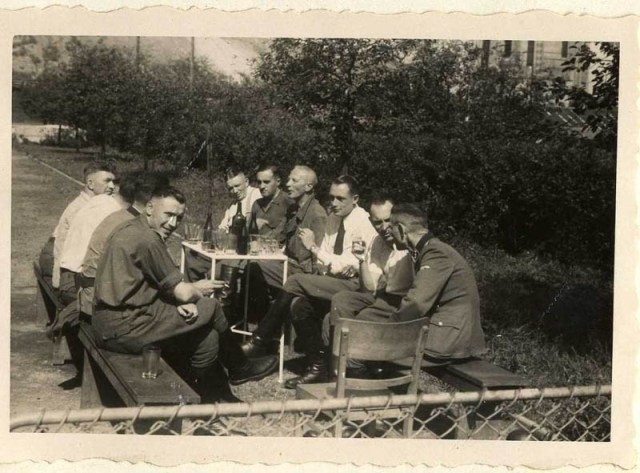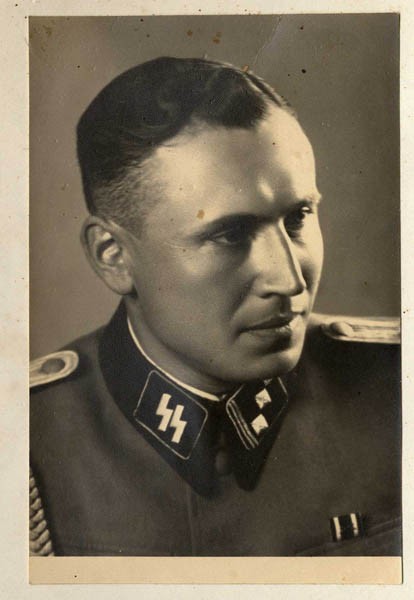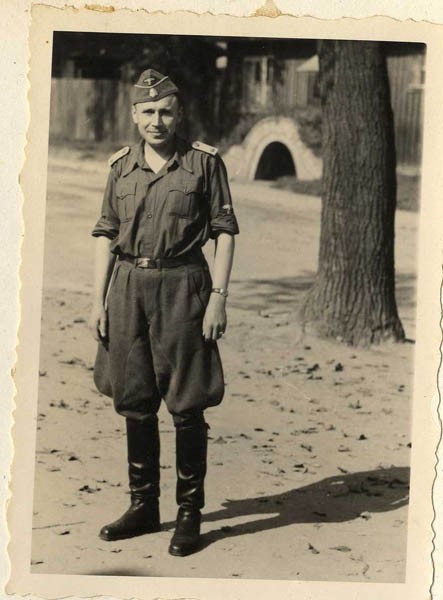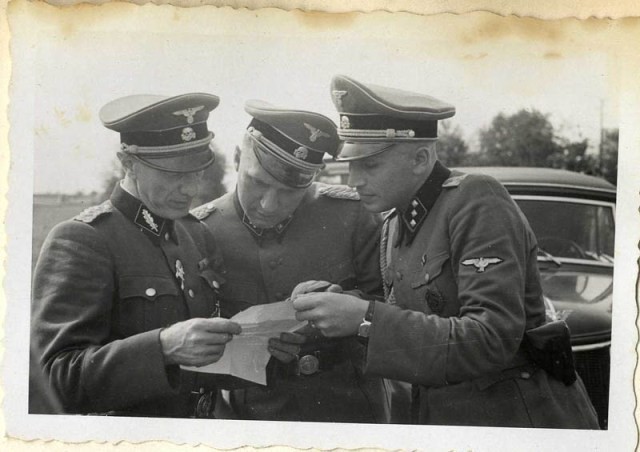
Collections Highlight: Auschwitz Through the Lens of the SS
Shortly after World War II, an American intelligence officer living in Germany uncovered a personal album of photographs chronicling SS officers’ activities at Auschwitz-Birkenau. The Museum received this photograph album in 2007. The rare images show Nazis singing, hunting, and even trimming a Christmas tree. They provide a chilling contrast to the photographs of thousands of Hungarian Jews deported to Auschwitz at the same time.
In January 2007, the United States Holocaust Memorial Museum Archives received a donation of a photograph album. The inscription "Auschwitz 21.6.1944" on its first page signaled the uniqueness of the album—there are very few wartime photographs of the Auschwitz concentration camp complex, which included Auschwitz-Birkenau, the largest Nazi killing center.
Though his name does not appear anywhere in the album, the dates of the photographs and various decorations including adjutant cords on the uniform of the album's owner, indicate that the album almost certainly belonged to and was created by SS-Obersturmführer Karl Höcker, the adjutant to the commandant of Auschwitz, SS-Sturmbannführer Richard Baer. Höcker was stationed at Auschwitz from May 1944 until the evacuation of the camp in January 1945.
The photographs depict Höcker with other SS officers in Auschwitz in the summer and fall of 1944 and provide us with a new understanding of their lives and activities in the camp. Even in the final months of the war, after Soviet troops had liberated concentration camps and labor camps to the east, SS officers stationed at Auschwitz enjoyed social functions and formal ceremonies. The album shows Auschwitz at a pivotal time—the period during which the gas chambers were operating at maximum efficiency—as the Hungarian Jews arrived and during the last months before the evacuation of the camp. The only other known album of photographs taken at Auschwitz, published as the "Auschwitz Album" (first published in 1980), specifically depicts the arrival of the Hungarian Jews and the selection process that the SS imposed upon them.
In December 2006, a retired US Army Lieutenant Colonel and former member of the Counter Intelligence Corps (CIC) wrote to the United States Holocaust Memorial Museum (USHMM) Archives. As one of its many tasks as a military intelligence agency, the CIC conducted investigations of Nazi perpetrators for US prosecutors in the Judge Advocate General's Office after World War II. While stationed in Germany in 1946, this officer had found a photograph album in an abandoned apartment in Frankfurt and had taken it home with him. Now elderly, he was ready to donate the album to the Museum, but wanted his donation to remain anonymous.
Karl Höcker, the SS officer who owned the album, shows up on almost every page of photographs, but rarely appears in historical records. Yet he was the adjutant to the commandant of the Auschwitz complex for some of the most murderous months of the camp's existence. Who was he? How did he get to Auschwitz? What did he do there?
Karl Höcker was born in Engershausen, Germany, in December 1911, as the youngest of six children. His father, a construction worker, was killed in World War I, and his mother struggled to support the family. Höcker, who worked as a bank teller in Lubbecke, joined the SS in 1933 and the Nazi Party in 1937. He married in 1937, had a daughter in 1939 and, in October 1944, a son. Upon the outbreak of war, Höcker was assigned to the Neuengamme concentration camp and spent the entire war administering various concentration camps. In 1943, he became the adjutant to the commandant at Lublin-Majdanek.
When SS-Sturmbannführer Richard Baer became the commandant of Auschwitz in May 1944, Höcker was also reassigned to the camp, again in the position of adjutant. Before he was executed for war crimes, Rudolf Höss, the most famous commandant of Auschwitz, described the role of the adjutant in his memoirs:
[The adjutant] is the first assistant to the Kommandant. He must ensure that no important event in the camp remains unknown to the Kommandant. The adjutant is the superior of all noncommissioned officers and men of the Kommandant's staff... The officer of the day and the first watch commander report to the adjutant, present their duty reports for this information and sign them...1
Höcker remained at Auschwitz until its evacuation, and then moved with Baer in January 1945 when Baer assumed command of Dora-Mittelbau. Höcker fled before the Allies liberated the camp. British troops captured him near Hamburg in possession of identification as a combat soldier. Lacking an accurate description of him, British authorities released Höcker in 1946 after only 18 months' incarceration in a prisoner-of-war camp. Until West German prosecutors began looking for him in the wake of the Eichmann trial, no one came for Karl Höcker. He resumed his life in Engershausen with his wife and two children. He had turned himself in for a de-Nazification proceeding in 1952 but did not serve any time. He took up gardening in his spare time and became the chief cashier of the regional bank in Lubbecke. Though he lost his job when he was indicted in 1963 during the Frankfurt Auschwitz proceedings in 1963-1965, he was rehired in 1970 after his release from prison.
Critical Thinking Questions
Why do militaries and individuals document their activities?
How might the German population and the local community in Poland have been aware of this camp, its purpose, and the conditions within?
Did the outside world have any knowledge about these camps? If so, what actions were taken by other countries and their officials? What choices do other countries have in the face of mistreatment of civilians?
How does the example of this camp demonstrate the complexity and the systematic nature of the German efforts to abuse and kill the Jews?





